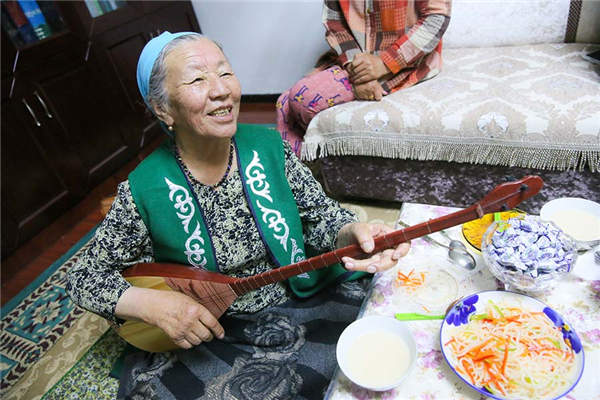Kazaks staying true to traditions of nomadic life

Aken Aites, or Aken songs, is a folk art form popular among members of the Kazak ethnic group.
Like most prairie nomads, the Kazak ethnic group in Tacheng, a county-level city in Xinjiang, roamed from place to place in search of rich pastures for their livestock. To make their nomadic lifestyle easier, the Kazaks invented a mobile dwelling called a yurt, which can be dismantled and reassembled easily. With an ancient history, the origin of the Kazaks can be traced to the Wusun people, who lived in the Ili River valley in the Han Dynasty (206 BC-AD 220) and later mingled with other groups, gradually evolving into the Kazak ethnic group.
The Kazak lifestyle is defined by its nomadic characteristics, which can be seen in their costume, cuisine, dance, music and sport. For example, their clothes were once mostly made of the skin of animals, such as sheep, wolves and deer. Women now tend to wear white, green and light blue colorful dresses. The Kazaks live off their animals, their staple food are dairy products and meat, and their diet contains few vegetables.
Kazaks are very skilled at singing and dancing. There are a lot of folk singers and some are honored with the title of akyn (a poet-singer and master of improvisation) or aken, after participating in several competitions and defeating the rivals. The Kazaks like summer best and often gather together on the prairie to host a special aitys, singing poetry competitions for akyns, in which solo performances, dialogue, chorus and other types of music are included. In addition to performing traditional songs, the most prominent akyns engage in improvisational performances about their lives on the prairie and their wonderful ideas.
Kazak dances also have their own unique features. They enjoy dancing and use dance to portray aspects of their nomadic lifestyles.
The Kazaks, men and women alike, are good horse riders, which is also demonstrated in their dance. For example, the traditional Kazak Dance Black Steed features horses running powerfully across the grasslands. Other labor activities such as milking, shearing and knitting, are reflected in their dances as well.
